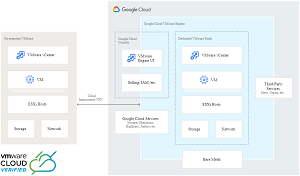News
Google Cloud VMware Engine Debuts in 2 U.S. Regions
With VMware services already available on the AWS cloud and Microsoft Azure, the Google Cloud VMware Engine is now generally available in two U.S. regions, enabling users to migrate existing VMware-based applications to the GCP, no refactoring or rewriting required.
Google in May announced the Google Cloud VMware Engine service, which provides a VMware Cloud Foundation stack. It's described as a hybrid cloud platform for managing virtual machines (VMs) and orchestrating containers, consisting of:
- VMware vSphere, the flagship cloud computing virtualization platform
- vCenter, a centralized management utility
- vSAN, storage virtualization software
- NSX-T, a full-stack Layer 2 to Layer 7 networking platform
- HCX, an application mobility platform for cloud migration
 [Click on image for larger view.] Google Cloud VMware Engine (source: Google).
[Click on image for larger view.] Google Cloud VMware Engine (source: Google).
As of now, users can run the service in the us-east4 (Ashburn, Northern Virginia) and us-west2 (Los Angeles, California) regions, with expansion to other regions around the world planned for the second half of the year.
Although VMware has a longstanding partnership with the Amazon Web Services (AWS) cloud for its virtualization wares, the company's tech also rolled out to Microsoft Azure shortly before GCP's May announcement. Now it runs on all of the "big three" cloud computing platforms, though in different services with different capabilities.
On the Google Cloud, the infrastructure environment consists of:
- Fully redundant and dedicated 100Gbps networking, providing 99.99 percent availability, low latency and high throughput.
- Hyperconverged storage via the VMware vSAN stack on high-end, all-flash NVMe devices, reportedly enabling fast performance with the scale, availability, reliability and redundancy associated with distributed storage systems.
- Recent-generation CPUs (2nd Generation Intel Xeon Scalable Processors), delivering high (2.6 GHz normal, 3.9 GHz burst) compute performance for workloads.
- 768 GB of RAM, and 19.2TB of raw data capacity per node.
It also provides integrated cloud networking so that VMware environments are configured via VPC subnets, and users can connect to workloads and services via direct, private, layer 3 networking.
Disaster recovery, backup, monitoring, security and other IT services are available from the GCP's third-party ecosystem, the company said.
More information is available in a June 30 announcement, and Google has published a getting started guidance for the new offering.
About the Author
David Ramel is an editor and writer at Converge 360.